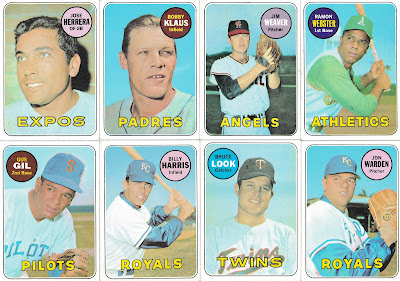In the past few weeks, I posted all the 1967 and 1968 rookie stars cards. Today we have all the 1969 rookie stars cards.
Comparison of the 3 sets:
1967 set
Total cards - 43
Teams with 3 cards - 5
Teams with 2 cards - 9
Teams with 1 card - 6
Mixed teams - 4 cards
1968 set
Total cards - 30
Teams with 3 cards - Orioles
Teams with 2 cards - 6
Teams with 1 card - 12
Teams with 0 cards - Giants
Mixed teams - 3 cards
1969 set
Total cards - 52
Teams with 4 cards - Padres, Royals
Teams with 3 cards - 6
Teams with 2 cards - 7
Teams with 1 card - 8
Teams with 0 cards - Senators
Mixed teams - 4 cards
As with the Giants in the 1968 set, there is no rookie stars card for the Senators here. The Senators had no major prospects, but Topps couldn't slap 2 schmoes on a Senators card, like they did here for the Angels and Athletics?
Two teams had a whopping FOUR rookie stars cards.
Of course they are expansion teams, whose rosters were filled with youngsters looking for a shot at the big leagues.
Bill Davis is back for the fifth of his FIVE rookie stars cards, this time not with the Indians.
Six teams had three rookie stars cards:
Not much to talk about here. Carl Morton's breakout year was 1970.
Probably the best rookie stars card in the 1969 set is the Richie Hebner/Al Oliver card. It's the only one where both players became stars. The Phillies' Larry Hisle and Don Money both became regulars. Sure, the Phillies were a bad team filled with holes, but Hisle and Money were both selected to the Topps All-Rookie team at the end of the season.
Carlos May was the most successful of these 14 players.
Seven teams had two cards:
After trading Joe Torre, the Braves carried two rookie catchers in 1969. Bob Didier ended up as the starter. As a kid, I thought that 2nd Cubs card looked strange. One guy has no ears, while the other two have ears to spare.
What, no George Korince? Topps finally stopped putting Korince on Tigers
Rookies cards, ending the possibility of another Bill Davis-type run.
Still, Korince appeared on TWO rookie cards in one year, something Davis
didn't achieve.
Graig Nettles is the best of this bunch. With a name like MITTerwald, you just knew he had to be a catcher.
Eight teams had just one rookie stars card:
After several seasons having three rookie cards, the Orioles had just one in the 1969 set. I guess their top-notch roster had no room for any more rookies. This is Lou Piniella's 4th rookie stars card (each with a different team). He was the AL Rookie of the Year in 1969, so this would be his last rookies card.
No Senators rookie card? Topps was just lazy here. After some of the players found on these cards over the years, Topps can't use "lack of prospects" as an excuse.
Finally, the "miscellaneous rookies from multiple teams" cards.
My contention has always been that Topps decided on the players for
these high-numbered cards after the current season had already started.
Hard to believe Rollie Fingers was an afterthought.
And why John Miller? Isn't a player automatically not a "star" when his stated position is "INF-OF"?










.jpg)


























.jpg)
















